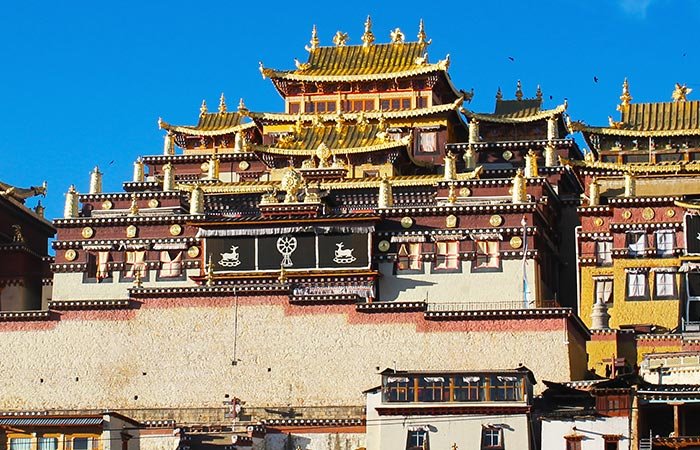Where am I : India Tour Packages » Most Popular Packages » Namtso Lake Tour Packages
View Details

Destinations Covered : Lhasa » Namtso Lake » Sera Monastery
Travel to Namtso Lake
Namtso Lake is a sacred lake of enormous spiritual value for Tibetans: its atmosphere refers to a place of seclusion surrounded by frozen mountains and close to the sky. It is the most significant and highest salt lake in the world, and judging by the images, it isn't easy to distinguish the limits between heaven and earth. Namtso, which means "heavenly lake" in Tibetan. The beautiful Namtso Lake, a classic Tibetan picture of turquoise waters between snow-capped peaks and grasslands where herds of yaks graze, has become the most popular destination in Lhasa. Namtso is the world's highest lake above sea level and the second-largest salt lake in China. Let's start our Travel to Namtso Lake.
About Namtso
Namtso Lake is an excellent natural site in Tibet. Namtso or Nam Lake is a mountain lake in the Tibet Autonomous Region in southeastern China. This lake is in the northernmost part of the region, a little over two hundred kilometers from the city of Lhasa. And is located at 4,718 meters above sea level and covers an area close to two thousand square kilometers. , having several landscapes to highlight.
This lake is seventy kilometers long from west to east and thirty kilometers wide from south to north, making it the second-largest saltwater lake in China and the highest in the world. Tourists who go there are amazed at the extraordinary beauty of this site and recommend it for any trip to Tibet. The main characteristics of this place, which are its solemnity, calm, and tranquility, are considered the symbols of the Tibetan plateau on which it is located. And all this is represented in its name Namtso which means the "heavenly lake" in fact, it is one of the sacred lakes of this entire region, and when you see its deep and crystalline blue color, you understand the meaning of its name. When you stop at the shore to look at the other side of the lake, and the sky is entirely blue, something that happens frequently, you can see how it seems that the water and the sky come together with their blue colors and their tranquility, making a landscape which is completely impressive, and which is said to be the one that manages to cleanse the souls of visitors, along with the purity of the water. Summer and the slightly warmer days of the other seasons are the best times to visit this Namtso Lake because that is when there is more biological activity and when it is much more pleasant to walk around. And it is that on days like them, all the animals that live there leave their places to finish decorating this whole space that is entirely natural and that makes visitors feel the joy and happiness that the Tibetans give Namtso. Namtso Lake's water comes mainly from rains, melted ice, and snow from Mt. Nyenchen Tonglha and the influx of crooks and streams, from where the lake is evident and limpid. With the sky-blue lake surface, the lake and the sky seem to be one and undivided.
What to see in Namtso Lake?
You can see small uninhabited islands that once served as a place of pilgrimage in the middle of Namtso Lake. It is said that these small islands contain caves that served as shelters for pilgrims. Pilgrims visit the islands during the winter when the lake freezes and spend their summers there. The largest island is Liangduo Island, located at the northwest end of the lake, 3.1 km from the shore. It is 2,100 meters long by 800 meters wide and rises 100 meters above sea level. There are also several rocky peaks visible from certain coasts. Some of these rocks have unusual shapes and were once the source of legend and many Tibetan tales. There is a sacred place for Buddhists near Namtso Lake at the southeastern end. It is the monastery of Zhaxi where thousands of Buddhist monks come to pilgrimage. The pilgrimage takes place every 12 years, during the year of the sheep. During the rite, the monks go around the lake in a clockwise direction to receive the grace of their gods. Around the lake are a great variety of wild animals such as yaks, antelopes, etc. The shores of Lake Namtso are also made up of vast meadows where animals stop to graze. The five islands of the lake are also home to some migratory birds. You can admire shoals of fish emerging from the water in search of the sun's rays. Namtso Lake is a natural bluish sea that extends almost 5,000 meters above sea level in Tibet. This splendid expanse of salt water makes more than one dream. This also explains why it is one of the three sacred lakes of Tibet where the faithful come on pilgrimage. Here, the blue of the waters blends with the blue of the sky, wild animals graze on the banks, and migratory birds nest for a few months. Everything is freedom, calm, and serenity. You can also see two pillars 30 meters high, one remarkable with a large crack. Tibetans believe that these pillars represent the gate of the god of Lake Namtso.
Attractions near Namtso Lake
This lake is a limestone peninsula that covers an area of ??about 10 square kilometers. In the center, there is a hill about ten meters high, and at the northern end of the peninsula, numerous strange peristalsis and stone peaks are lined up. There is a natural stone bridge connecting the mountains. As the arm has long been eroded by water, there are stunning rocks caves filled with stalactites that form unique karst topography. Around the Namtso, five different peninsulas extend into the lake in five directions.
Tashi Temple
Namtso religious activities are most concentrated in Tashi Dor. There is a Tashi Temple, which is still surrounded by big smoke on the peninsula. There is a long cave called Lianhuasheng Cave.
Yingbin Rock
You will first see the Yingbin rock along the circle path to the lake's shore. Numerous long flags falling from the top of the hill colorfully adorn the stone.
Mani Cluster
On the bank of the Namtso, there are many clusters of rocks called Mani Dui. Look up. The blue sky and clean water are inseparably connected. The meadows on the shore of the lake resemble a giant green carpet with endless views.
Campfire
If you stay overnight here, you can set up a campfire on the peninsula.
Riding horses and Yaks
Traveling to Namtso, you can ride horses and yaks there. Taking a slow ride along the fantastic lake is an enjoyable activity.
Pilgrimages
Believers say that every year of, sheep, Buddha, Bodhisattvas, and Dharma protectors assemble the assembly here. If people come here and go around the lake, they will separate 100,000 times the pebble than usual. Every sheep year, monks and believers go for a trek here, and April 15th is the boom season.
Natural visits
Namtso Lake has a vast expanse of water as far as the eye can see. The pure water rippled slightly under the pure blue sky. Along the shore are huge well-proportioned Mani stones. The colorful prayer flags hung on the hills and monasteries make Namtso Lake sacred and mysterious. Many huge stones have existed throughout Namtso for thousands of years and are related to some beautiful Tibetan stories. Namtso Lake is also a paradise for animals. It is a natural pasture for the nomads of northern Tibet. You have the opportunity to see sheep and yaks grazing peacefully in the meadow. Many wild animals also inhabit here, such as wild yaks, donkeys, wild foxes, etc.
Culture experience
Namtso Lake, in Tibetan, means "the Lake of Heaven." It is honored as the sacred lake for both Tibetan and Bön Buddhism. Natmso Lake is the birthplace of ancient Zhang Zhung, who was a powerful kingdom 18,000 years ago in Tibet. Today, Namtso is more popular with Buddhists. It is believed to be the Cakrasamvara ashram of esoteric Tibetan Buddhism. Buddhists have become a tradition to do the Kora around Lake Namtso. Pilgrims walk or prostrate along the shore of the lake and pray to the lake. The year of the goat is the best year to do the Kora.
Good reasons to visit Namtso Lake
The highest salt lake in the world
Namtso Lake is found in Tibet, a region located southwest of China, Fed by the glaciers of the Himalayas and an exceptional surface area. It offers a breathtaking spectacle for anyone who ventures to the top. Within it are five small islands, uninhabited but which can be visited, especially in winter when the lake is frozen. Similar to a sea in its salty water, blue color, and expanse, it is a wonder of nature that you cannot miss if you are in the Tibet region.
A sacred Buddhist place
For Tibetan Buddhists, Lake Namtso is one of the three sacred lakes, along with Lake Yamdrok-Tso and Lake Manasorovar. In particular, you can admire the Zhaxi temple, a significant place of pilgrimage. The year of the goat in the calendar marks the gathering of all the faithful around the lake. It consists of praying and prostrating with each step while going around the lake clockwise, which takes between 20 and 30 days! Some pilgrims even cross the frozen lake and go to one of the islands that make it up to meditate from one winter to the next. During the year of the sheep, which takes place every 12 years, all the Buddhist monks meet for a joint pilgrimage.
Animal paradise
The lake is rich in a particular fauna, specific to high mountains and salt water. Thus, fish abound in the lake, and wild birds find refuge during migration. The green pastures, formed by the abundance of salt water, are ideal and attract many mammals that come to graze there all year round. In particular, you can see bison, goats, yaks, antelopes, wild donkeys, etc. All these animals search for the hottest ray of sunshine and put on a fantastic sight. Don't miss a yak ride around this magical expanse!
Breathtaking shades of color
Namtso Lake also offers landscapes of exceptional beauty that you will remember for a long time! A pure and brilliant blue regularly merges with the sky, giving a strange feeling of emptiness. Alongside its cold and salty crystalline, the contrast of the snow-capped mountain and the bright green meadows enchant visitors! Amateur or experienced photographers will be thrilled!
Things to do in Namtso
You can join or explore a few activities if you travel to Namtso at the right time. For example, you can participate in or watch the Shoton Festival, campfire or horseback riding, or make pilgrimages.
Sunrises and sunsets
In Namtso, sunrises and sunsets are breathtakingly beautiful! The vast lake and snow-capped mountains capture the sun's rays beautifully, the angle of which remains low at these times of the day. In the morning, protect yourself from the cold and get up early to go to the shores of the lake to admire the sunrise. Far behind, as a backdrop, you will find icy blue water and gray mountains. As the sun rises, clouds emerging from the hills bathe in a bed of golden rays. At dusk, the clouds turn red and gold. You can sit near the lake to observe the color variations of the sky.
Shoton Festival
Every year, at the end of June and beginning of July, the Shoton Festival. In Tibetan, Shoton means eating yogurt, also called the "Yogurt Festival." During the Shoton Festival, Namtso will hold a hiking meeting and a hike on the ancient road of Jiashan. The walk-in Namtso is very famous.
Riding Horse and Yak
Traveling to Namtso, you can ride a horse and yak here. Riding slowly along the sacred lake is an enjoyable activity.
Beautiful landscapes
On a clear day, the waters of the lake are a magnificent turquoise color, surrounded by magical views of the surrounding mountains. The large open spaces, dotted with the tents of local nomads, will amaze you. You can also walk by the lake or discover the surroundings by climbing the first surrounding hills.
Pilgrimages
Believers say that every goat year, Buddhas, bodhisattvas, and the dharma protector fix the dharma assembly here. If people come here and walk around the lake, it exceeds 100,000 times the chant that d' habit. So every Goat Year, monks or believers will trek here, and April 15th is the peak.
Went around the lake, praying
Namtso Lake remained a sacred site for centuries. At the end of winter, equipped with their provisions, the Buddhist pilgrims used to cross the lake on its frozen surface. Then they would return by the same route the following winter. Now, for security reasons, the Chinese authorities prohibit this practice, recognized as too dangerous. BuddhiBuddhistsve that a person who walks around the lake in the year of the goat and his family healthy and safe will acquire knowledge and other virtues.
Hikes and picnics around the lake
A place steeped in serenity, Namtso Lake displays magnificent natural landscapes. You will enjoy a walk around it. You will spend a carefree moment listening to the wind and watching the ripples flicker on the water's surface. Standing on its arm of Tashi land, you will feel in the lake's center. At the edge, the crystal clear waters are home to many fish you may be lucky to see. During your walk, you will also see yaks and goats grazing in the surrounding meadows. It is an excellent idea to picnic around the lake while admiring these beautiful landscapes at Lake Yamdrok. If you book the Tibet tour with us, we will prepare for this picnic: instant coffee, cake, yogurt, fruits, etc.
Where to sleep and eat at Lake Namtso?
In winter, only Tibetan nomads stay there. In the "good" season, shops and prefabricated huts serve as restaurants and basic hotels or guesthouses. It has basic rooms with an outside bathroom, but without a doubt, the landscape makes up for the inconvenience. It is more likely that you will not be able to sleep because of altitude sickness than the accommodation type.
Things to know before you go
- Come prepared with warm clothes, even if you are only visiting during the day in the summer.
- Plan to travel to the Tashi Peninsula, known for its excellent views.
- Expect a smooth journey as the road to Namtso Lake is in good condition.
- Bring food with you, as lakeside options are limited and expensive.
- Wear sunglasses, the sun at that height damages the eyes.
- Do not forget the flashlight or, better, the headlamp. You will need it if you go to the bathroom at night.
- Be respectful to the Tibetans. For them, it is a sacred place.
- Before climbing Namtso, you must have acclimatized for several days at lower altitudes, such as in Lhasa. If you are not acclimatized, you can suffer from Altitude Sickness, which is not silly.
Best time
Sunset and sunrise are the most exciting times for photography as both last only half an hour. Sunrise usually occurs around 7 am earlier in summer and later in winter. Photograph the quiet south side of the Tashi Peninsula and the golden mountains of Nyainqentanglha. Shoot to the north shore of the Tashi Peninsula Lake. The landscape of Lake Namtso is very diverse. You can also find many amazing scenes at other times.
How to get to Namtso?
It usually goes from Lhasa to Namtso. Lhasa is about 220 km from Namtso. Tourists typically fly to Lhasa Gonggar Airport and then take the bus to the lake. Lhasa Eastern Suburb Passenger Station offers regular buses to Namtso and other attractions at varying intervals. And you can also take the bus to Dangxiong County first, then a charter car to Namtso. You can find rental autos in every travel agency and hotel. Besides, you can also use other ways to get to Namtso, such as self-driving, horse riding, hiking, etc.
Travel to Namtso Lake provides fantastic views that can be enjoyed from any point of the lake. The lake is immense, of intense blue color, and is surrounded by snow-capped mountains. It is nature in its purest state.
Speak to our Experts!
Instant Quote, Best Deals - 100% Customizable, Includes hotels + car + guides Cost depends on various factors like, number of people you are, travel dates, category of hotel and transportation etc.Drop your Inquiry to get the best deals as per your requirements. 100% Satisfaction Guaranteed. Rated 5* in TripAdvisor.Loading...




